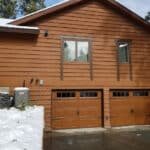The most important thing is to keep private property safe. Whether you live in an apartment or a house, everyone wants to make their home harder to break into. Homes that are on their own but have connected garages are more vulnerable because they can be used as entry points. Modern garage doors have many protection features that make them safe, but an extra one can’t hurt.
Installing a garage door lock or latch is a good idea that won’t break the bank. Also, the garage door lock kit is easy to install and won’t break the bank if you do it yourself.
Here is a short and helpful guide on how to install garage door slide locks. Jump in and figure out how to do it.
Understanding the Garage Door Mechanism
Before delving into the step-by-step guide, let’s first understand how this lock functions and what you must do to prepare for its installation.
The garage door slide lock, often called a side lock or latch, is designed to be used from the inside or outside overhead garage doors. At its core, a metal bar or rod is manually slid into the garage door’s track or rail to keep it from opening.
Once activated, the lock extends into the track, securing the door in its closed position. This is a substantial barrier, making it challenging for anyone to force open the door from the outside, even if they manage to get past the primary locking mechanism.
Primary Components of a Standard Garage Door
The garage door comprises multiple parts, each playing a crucial role in its operation. Here are the primary components of a standard garage door:
- Panels: These large rectangular sections make up the door’s body. They can be made of wood, steel, aluminum, or composite materials.
- Tracks: Metal guides along which the door rollers move, allowing the door to open and close. There are usually vertical tracks on either side of the door and horizontal tracks attached to the ceiling.
- Rollers: Small wheels that fit into the tracks and help the door move smoothly up and down.
- Springs: Powerful springs that counterbalance the weight of the door. Two main types are torsion springs (above the door) and extension springs (along the sides).
- Cables: These are attached to the bottom corners of the door and run up to the springs, helping lift and lower the door.
- Hinges connect the door panels, allowing them to fold as the door is raised or lowered.
- Opener: This motorized device is responsible for opening and closing the door. It is usually installed on the garage ceiling and is connected to the door through a trolley and an arm.
- Remote Control/Transmitter: A handheld device or wall-mounted switch that activates the opener.
- Safety Sensors: Located near the base of the door tracks, these sensors detect obstructions in the door’s path and prevent the door from closing if something is detected.
- Weatherstripping: This is found at the bottom of the door and seals the gap between the door and the ground, preventing drafts, water, and pests from entering the garage.
- Locking Mechanism: This can be manual or automatic, ensuring the door remains closed and secured.
- Windows (optional): Some garage doors have windows for aesthetics or to allow natural light into the garage.
Remember, while these are the primary components of a standard garage door, designs and features might vary based on the type and brand of the door. Refer to the manufacturer’s documentation for specific details about your garage door.
Preliminary Steps Before Installation of Garage Door Slide Locks
Before you install a garage door slide lock, it’s essential to carry out some preliminary steps to ensure a smooth installation process and optimal lock function. Here are the steps you should follow:
Safety First
- If you have one, disconnect the garage door opener to prevent it from accidentally activating during the installation.
- Ensure that the garage door is fully closed and in a stable position.
Inspect the Door
- Examine the condition of the garage door. Ensure no significant damage or misalignment could interfere with the lock’s installation or function.
- Check the tracks and rollers for any obstruction or dirt.
Choose the Right Lock
- Not all slide locks are compatible with every garage door type. Ensure your chosen safety is appropriate for your door material and design.
- Consider purchasing a high-quality, durable lock to ensure longevity and enhanced security.
Gather Necessary Tools
- Most slide lock installations require essential tools such as a drill, screws, screwdriver, measuring tape, pencil or marker, and possibly a metal file.
- Refer to the installation guide with the lock for any specific tools you might need.
Clean the Area
- Wipe down the inside of the door where the lock will be installed. Ensure the area is free of dust, grease, and debris for optimal adherence and function.
- Clear the area around the garage door of any obstacles or items that might interfere with the installation.
Mark the Installation Points
- Using the measuring tape and pencil or marker, measure and mark the exact points where you’ll attach the slide lock. This helps ensure precise placement and alignment.
Review Installation Instructions
- Before you begin, thoroughly read the manufacturer’s installation instructions with the slide lock. This will give you a clear understanding of the steps and any specific nuances related to your lock model.
Enlist Help if Needed
- While many people can install a slide lock alone, having an extra set of hands can be helpful, especially if you’re unfamiliar with such installations.
Following these preliminary steps, you’ll set yourself up for a successful and safe installation of your garage door slide lock. Always prioritize safety and ensure you’re comfortable with the process before starting. If in doubt, consider hiring a professional to handle the installation.

Garage Door Slide Lock Installation Guide
Installing a slide lock on your garage door can add an extra layer of security. A slide lock, also known as a latch or a bolt, allows you to lock the garage door from the inside, making it more difficult for an intruder to open the door. Here’s a detailed guide on how to install a slide lock on your garage door:
Materials and Tools Required
- Slide lock kit (should include the lock, bolt, and keys)
- Pencil or marker
- Ruler or measuring tape
- Drill and drill bits
- Screws (usually provided in the kit)
- Screwdriver
- Metal file (optional)
1. Preparation of the Installation Area:
- Before starting, ensure your safety by disconnecting the power to any automated garage door opener.
- Clean the designated area on the door where you’ll be attaching the lock. Wipe it down to remove dust, grease, or any other residues. A clean surface ensures a sturdy installation and smooth operation.
- Clear any items or obstructions nearby that might interfere with the installation process.
2. Determining the Slide Lock Placement:
- Using a measuring tape, determine the optimal location for your slide lock. Remember, safety should be easily accessible and effective in its function.
- Once you’ve decided on the right spot, mark the position using a pencil or a marker. This will serve as your reference during installation.
3. Drilling the Required Holes:
- Refer to the installation manual or guide provided with your slide lock. Based on its design, it will specify the size and number of holes needed.
- Carefully drill the holes at the marked positions using an appropriate drill bit. Make sure to drill straight to avoid any alignment issues later.
4. Attaching the Slide Mechanism:
- Position the slide lock over the drilled holes. Double-check its alignment with your markings.
- Secure the slide mechanism to the garage door using the provided screws or those recommended in the manual. Tighten the screws, ensuring the slide moves smoothly and isn’t overly tight.
5. Setting Up the Receiving Bracket:
- The receiving bracket is what the slide lock will latch into. This bracket must align perfectly with the slide for the safety to function correctly.
- Position the bracket in alignment with the slide, marking its screw holes.
- Drill the necessary holes for the bracket, then secure it in place using screws.
6. Testing the Slide Lock Mechanism:
- After installation, it’s crucial to test the functionality of the slide lock.
- Engage the slide lock, ensuring it fits securely into the receiving bracket.
- Disengage the lock, checking for smooth operation. Repeat this process multiple times to ensure consistent and reliable performance.
- If you notice any friction or misalignment, make the necessary adjustments.
Safety Protocols
Protective Gear is Essential: Always wear safety gloves and protective goggles during installation to minimize the risk of potential injuries.
Stabilize the Garage Door: Before installing, ensure the garage door is securely in place to avoid any unexpected movements.
Upkeep and Maintenance
Regularly Check the Lock: To maintain optimal functionality and prevent potential issues, it’s essential to inspect the lock at regular intervals.
Cleanliness and Lubrication: To ensure smooth operation and extend the lock’s longevity, periodically clean its parts and apply appropriate lubricants.
Addressing Common Problems
Mismatched Lock Dimensions: Verify the slide lock’s measurements against your garage door’s specifics before purchasing to avoid any fitment issues.
Stiff Locking Action: A lock that’s hard to move may indicate either dirt build-up or the need for lubrication. Routine care can address these challenges.
Misalignment with Receiving Bracket: Careful marking and precise measurements during installation will prevent alignment problems.
Enhancing Security Measures
Syncing with Alarm Systems: Enhance your security by linking the slide lock with an advanced alarm system. This can provide immediate notifications in case of attempted breaches.
Garage Door Reinforcements: Beyond just a slide lock, think about adding extra layers of security, such as security bars or advanced sensors, to fortify your garage’s defenses.
A garage door slide lock is a judicious approach to augmenting garage security. Through meticulous installation and periodic maintenance, one can ensure the sanctity of their valuable assets and enjoy serenity.
Choose GC Garage Doors as your Garage Door Partner
Garage door problems don’t have to be hard to deal with, especially if you know how to install garage door slide locks. Remember that it’s not just about keeping your things safe; it’s also about keeping your home safe. GC Garage Doors is there to help you if you ever get stuck or need help from a professional. Our team knows a lot about garage doors and how to install slide locks, among other things. Our website has a lot of helpful tips and guides that will help you learn more about garage doors. Don’t hesitate to call us at (708) 294-8864 if you have any questions or need our expert help. We’re here to help ensure your garage door works perfectly and keeps unwanted people out of your home.








